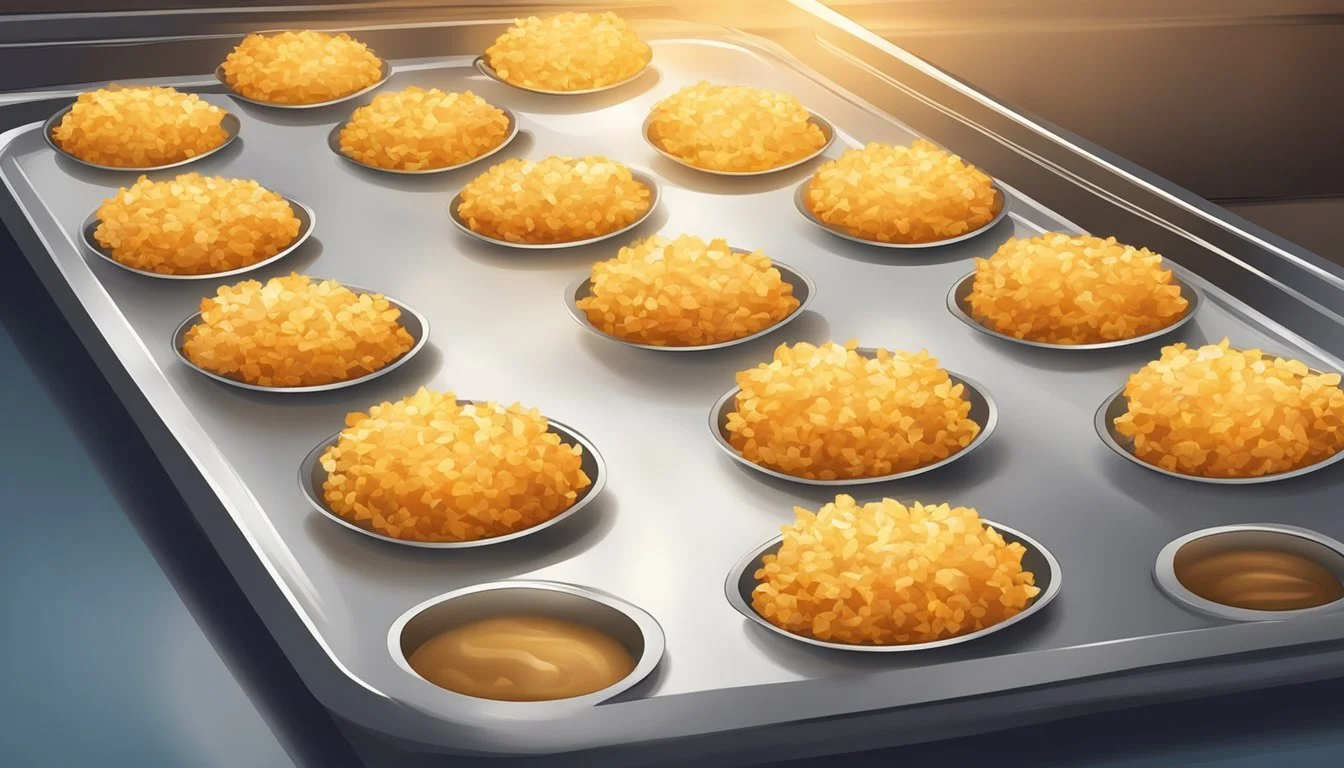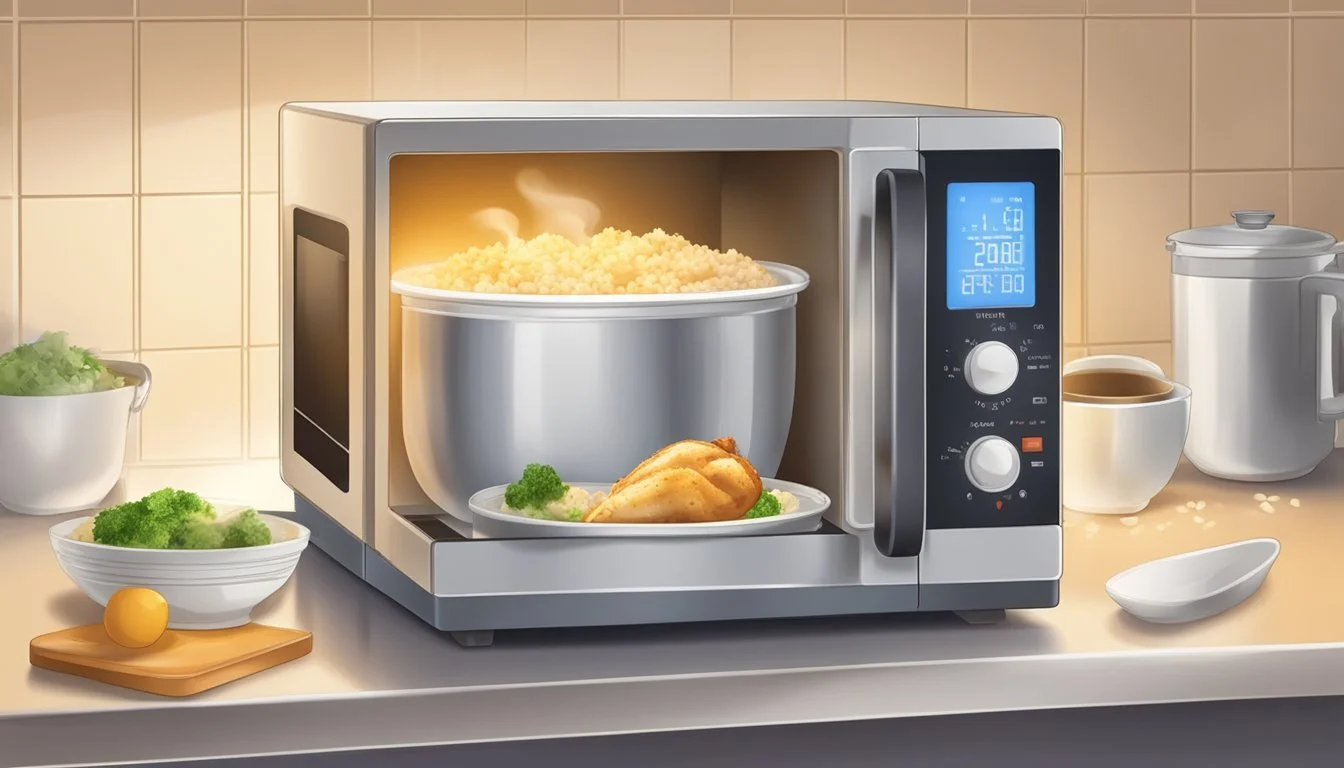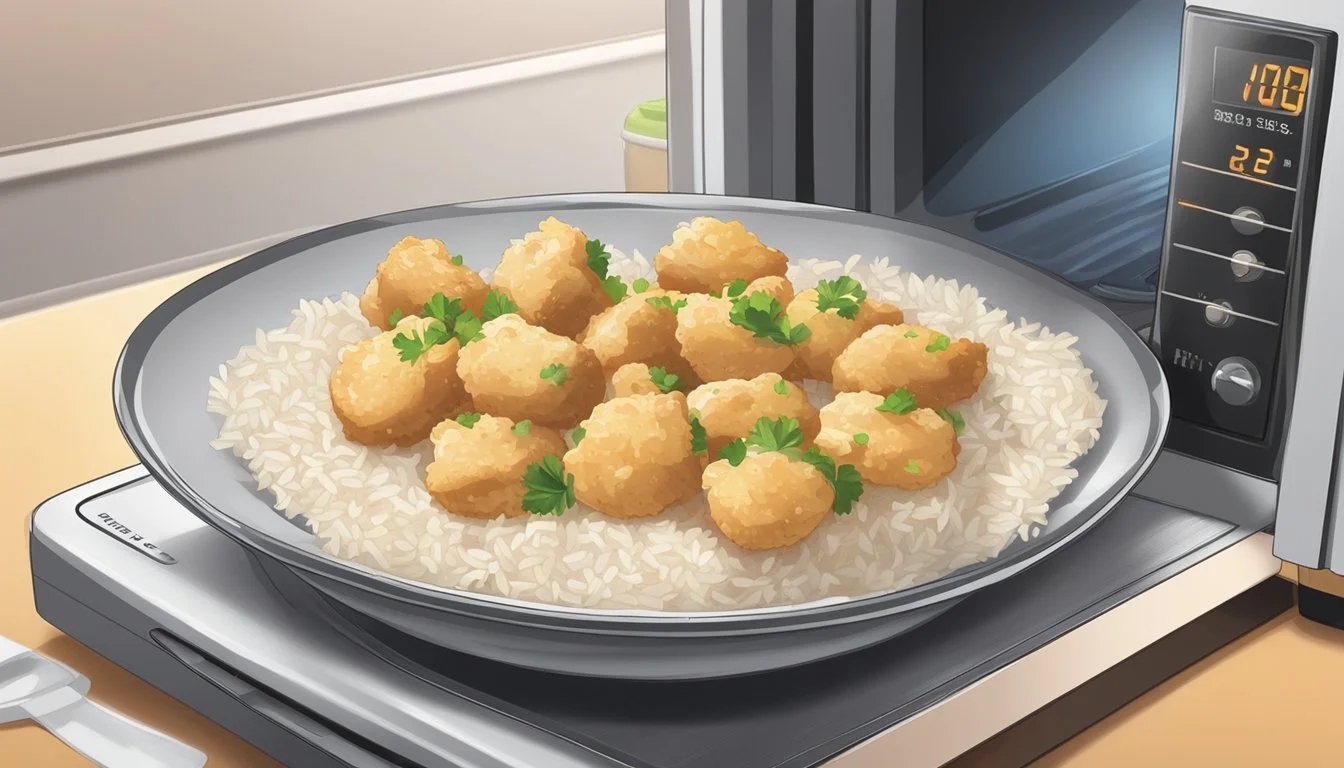How to Reheat Chicken and Rice Bites for Perfect Taste and Texture
Chicken and rice bites are a convenient and delicious meal option, whether they're leftovers from a previous dinner or a prepared batch for busy days. Knowing the best way to reheat them ensures they remain tasty and moist. To reheat chicken and rice bites, preheat the oven to 350°F, arrange them in an oven-safe dish, and add a small amount of chicken stock or water to retain moisture.
Cover the dish with aluminum foil to lock in steam and prevent drying. Bake until the internal temperature reaches 165°F for the best results. For those who prefer a quicker method, microwaving is an option, though it may not provide the same crisp texture that the oven does.
Proper reheating method not only preserves the flavors but also ensures food safety. With the right technique, your chicken and rice bites can be just as delightful as the day they were first made.
Understanding the Basics of Reheating
Reheating chicken and rice bites requires careful attention to food safety, temperature control, and moisture retention. These aspects will help ensure that the reheated meal remains safe to eat and retains its original taste and texture.
Food Safety Considerations
When reheating, the primary concern is food safety. Bacteria such as Salmonella and Listeria can grow in improperly stored or reheated leftovers. To prevent food poisoning, heated dishes must reach an internal temperature of 165°F (74°C).
Store leftovers in airtight containers and refrigerate them within two hours of cooking. If leftovers have been in the fridge for more than three days, it's safer to discard them. When using a microwave, cover the food to promote even heating and avoid cold spots where bacteria could survive.
Effects of Reheating on Chicken and Rice Taste and Texture
Reheating chicken and rice can lead to dryness if not handled properly. To maintain moisture, add a small amount of water or chicken stock to the dish before reheating. Use a method that evenly distributes heat, such as an oven or stovetop, to avoid overcooking.
Chicken skin tends to lose its crispiness when reheated. For crispy skin, use an air fryer or remove any covering (like foil) during the last few minutes of oven reheating. Rice may become hard or gummy. Ensuring added moisture and avoiding excessive reheating time can help retain its texture.
Using proper methods ensures that reheated chicken and rice bites are both safe and enjoyable to eat.
Preparation for Reheating
Reheating chicken and rice bites requires a few essential steps to ensure the meal retains its texture and flavor. The key areas to focus on include bringing ingredients to room temperature and properly preheating your appliance.
Bringing Chicken and Rice to Room Temperature
Before starting the reheating process, remove the chicken and rice bites from the fridge. Allow them to sit at room temperature for approximately 20-30 minutes. This step helps to avoid uneven heating, which can result in cold spots or dried-out food.
Using a shallow dish can facilitate this process. Avoid: Exposing the chicken and rice to direct sunlight or overly warm areas. If the food has been refrigerated in a very cold section, slightly increase the sitting time accordingly.
Preheating Your Device
Depending on the method selected, preheating your oven, microwave, or skillet is crucial. For oven reheating, set the oven to 350°F (175°C) and allow it to fully preheat. This ensures consistent heat throughout the dish.
For microwave use, setting it to medium power helps in reheating without drying the food. Skillets require a low to medium flame, adding a small amount of water or broth to create steam.
Using an oven-safe dish with a lid or aluminum foil helps in locking in moisture for better results. Make sure not to skip this step, as a well-preheated appliance is crucial for a tasty, reheated meal.
Reheating in the Microwave
Properly reheating chicken and rice bites in the microwave ensures they remain moist and delicious. Using the correct containers, following specific microwaving tips, and adding moisture through water or broth are key strategies.
Using Microwave-Safe Containers
Always place chicken and rice bites in microwave-safe containers to prevent harmful chemicals from leaching into the food. Opt for containers labeled explicitly for microwave use, such as glass or microwave-safe plastic.
A microwave-safe plate can also be effective for reheating. Cover the food with microwave-safe plastic wrap or a microwave-safe cover, leaving a small vent to allow steam to escape.
Avoid using styrofoam or metal as these materials are not safe for microwave use. Ensuring the right container maintains food safety and helps retain heat evenly.
Microwaving Tips for Even Heating
To achieve even heating, it’s crucial to heat chicken and rice bites in short intervals. Start with 30-second to 1-minute intervals at medium power. After each interval, stir the rice and flip the chicken to promote uniform heating.
Using an internal thermometer can be helpful. Heat the chicken to at least 165°F to ensure it's safe to eat. Spreading the food in a single layer on the plate can further assist in even heating.
This method prevents overcooking or drying out parts of the meal while leaving others cold.
Using Water or Broth for Moisture
Maintaining moisture is essential for reheated chicken and rice bites. Sprinkle a teaspoon or two of water over the rice before microwaving to prevent it from drying out. Chicken broth can serve as an excellent alternative to water, adding flavor and moisture simultaneously.
Place the rice and chicken in the container, and then add a small amount of water or broth. Cover with plastic wrap or a microwave-safe lid, leaving a vent for steam.
These small additions keep the food from becoming dry and enhance the texture and taste of the meal.
Reheating on the Stovetop
Ensuring moist and juicy chicken and rice bites when reheating on the stovetop requires attention to the right tools and techniques. This section outlines the process using specific steps and considerations to get the best results.
Choosing the Right Pan
Selecting a pan is crucial. Non-stick pans or skillets help to evenly distribute heat and reduce sticking. A medium-sized non-stick skillet that has a lid is ideal for maintaining moisture. Using olive oil or butter prevents the food from drying out.
Maintain a medium heat setting to prevent overcooking. For best results, ensure the pan is hot before adding the chicken and rice bites.
Stovetop Technique for Chicken
Start by adding olive oil or butter to the hot skillet. Place the chicken pieces in the skillet ensuring they are spaced out. Cover with a lid to retain moisture. A few tablespoons of water or chicken stock can be added to keep the chicken juicy.
Reheat for 5-8 minutes, turning occasionally to avoid drying out. Bone-in chicken may need more time, while smaller pieces may reheat faster. Check if the internal temperature reaches 165°F.
Stovetop Technique for Rice
Rice requires a different approach to keep it from becoming mushy. Add a small amount of olive oil or butter to the skillet and heat. Spread the rice evenly to prevent clumping.
To keep the rice moist, sprinkle a few drops of water or chicken stock over it and cover it with a lid. Heat over medium, stirring occasionally, for 5-7 minutes. Ensure the rice retains its fluffiness without sticking to the pan.
By following these steps, chicken and rice bites can be effectively reheated on the stovetop while maintaining their moisture and flavor.
Reheating in the Oven
Reheating chicken and rice in the oven is an effective way to ensure both components are warmed thoroughly without becoming dry. The process involves careful preparation and attention to temperature.
Oven Safety and Setup
Preheat the oven to 350°F (175°C). Using an oven-safe dish is crucial to avoid any potential hazards. Ensure that the chicken is placed in a single layer, not stacked, to promote even heating.
For added protection, cover the dish with aluminum foil. This helps retain moisture and prevents the food from drying out. Use a wire rack on top of a baking sheet if you want to collect any drippings for easy cleanup.
Oven Method for Moist Chicken
To keep the chicken moist, place the pieces in an oven-safe dish with a small amount of liquid—chicken stock or water works well. This added moisture creates steam during reheating, which helps in maintaining the chicken's tenderness.
Cover the dish tightly with aluminum foil. Bake at 350°F for about 25 minutes, or until the internal temperature of the chicken reaches 165°F (74°C). For a crispy finish, remove the foil in the last 5-10 minutes and use the broiler setting briefly, being careful not to burn the chicken.
Optimizing Reheat for Rice
For rice, spreading it evenly in an oven-safe dish and adding a few teaspoons of water ensures moisture is well-distributed. Breaking any clumps before reheating helps achieve uniform warmth.
Cover the rice with aluminum foil to trap steam inside. Heat at 350°F for 15-20 minutes, stirring occasionally if needed. If using a combined dish with chicken and rice, follow the chicken's heating guidelines ensuring both elements reach the desired temperature without dry spots.
Using an Air Fryer for Reheating
Reheating chicken and rice bites in an air fryer can bring both efficiency and quality. The air fryer ensures that the chicken remains tender while maintaining a crispy skin. Additionally, the rice can regain a just-out-of-the-oven texture.
Air Fryer Advantages for Chicken
Using an air fryer is an effective way to reheat chicken due to its ability to maintain juiciness while creating a crispy exterior. Preheating the air fryer to 360°F (180°C) is recommended to achieve the best results. Arrange the chicken in a single layer in the air fryer basket, and apply a light spritz of nonstick spray or brush with a small amount of olive oil. This technique is particularly useful to reheat fried chicken and reheat rotisserie chicken without drying it out. The chicken typically needs 3-5 minutes to reach a safe internal temperature of 165°F (74°C). For larger pieces, it may be beneficial to slice them about ½ inch (1 cm) thick to ensure even heating.
Reheating Rice in the Air Fryer
Reheating rice in the air fryer may not be conventional, but it is quite effective. Begin by preheating the air fryer to a lower temperature, around 300°F (150°C). Place the rice in a heat-safe dish that fits comfortably within the air fryer basket. A light mist of water or a small pat of butter can help keep the rice moist and prevent it from drying out. Heat the rice for about 5-7 minutes, stirring halfway through to ensure even warming. The air fryer helps to bring back a fluffy texture to the rice, making it as enjoyable as when it was first cooked.
Alternative Reheating Methods
To enhance the flavor and texture of chicken and rice bites, consider using a steamer to retain moisture or incorporating additional ingredients like vegetables or sauces.
Using a Steamer for Moisture Retainment
A steamer is an excellent method for reheating chicken and rice bites, as it helps retain moisture. Begin by prepping the steamer basket with parchment paper to prevent sticking. Fill the bottom compartment of the steamer with water, ensuring it doesn't touch the basket.
Place the chicken and rice bites in the basket, leaving space between each piece for even steaming. Cover and steam over medium heat for about 5 to 8 minutes, checking periodically. This method prevents dryness, maintaining the bites' original tenderness.
To enhance flavor, you can add herbs or spices to the steamer water. This adds a subtle infusion of taste to the chicken and rice bites.
Reheating with Additional Ingredients
Reheating chicken and rice bites can be an opportunity to add new flavors. Start by preheating a skillet over medium heat and adding a small amount of oil. Place the bites in the skillet, ensuring they are evenly spaced.
To enhance the dish, consider incorporating vegetables like bell peppers, onions, or spinach. Sauté the vegetables first for a few minutes, then add the chicken and rice bites. Stir occasionally to ensure even heating.
Adding a sauce can also elevate the dish. Simple options include teriyaki, soy, or a light cream sauce. Pour a small amount over the bites and vegetables in the skillet and mix well. Heat until the chicken is thoroughly warmed and the internal temperature reaches 165°F.
This method not only reheats the chicken and rice bites but also transforms them into a more complex, flavorful meal.
Post-Reheating Tips
Reheating chicken and rice bites effectively is just one step. It's equally important to follow up with precise post-reheating actions to ensure your meal is both delicious and safe to eat.
Resting Time after Reheating
After removing the chicken and rice bites from the oven or microwave, allow them to rest for a few minutes. This resting period helps the heat distribute evenly throughout the food. It also allows the moisture to redistribute, which can enhance the texture and flavor of the bites.
Letting the food sit undisturbed on a warm plate for about 3-5 minutes can make a significant difference. By not cutting into the bites immediately, you avoid the risk of losing valuable juices that keep the dish succulent.
Checking for Desired Temperature
Using a food thermometer is crucial to ensure the chicken has reached a safe and suitable temperature. Insert the probe into the thickest part of the chicken to check that it has reached at least 165°F (74°C). This temperature ensures that any harmful bacteria are destroyed and the food is safe to eat.
If you notice any cold spots, return the chicken and rice bites to the heat source for a few more minutes. Always aim for an evenly piping hot dish to guarantee both safety and enjoyment.
Serving Your Reheated Chicken and Rice
Presentation matters when serving reheated chicken and rice bites. Arrange the bites on a clean plate and garnish with fresh herbs or a squeeze of lemon juice to enhance the flavor.
Accompanying the bites with a side of steamed vegetables or a crisp salad can provide a balanced meal. Also, consider providing small bowls of dipping sauces for added taste. These simple additions can turn a reheated dish into an enjoyable and appetizing meal.
Storage and Handling of Leftovers
Proper storage and handling of leftover chicken and rice bites ensure food safety and quality. By following these best practices, your leftovers can remain fresh, tasty, and safe for future reheating.
Storing for Future Reheating
Storing leftover chicken and rice bites correctly is crucial for maintaining texture and flavor. Airtight containers or wraps are best for minimizing air exposure, which can cause drying out and flavor loss. Place the leftovers in the fridge if you plan to consume them within 3-4 days.
For longer storage, consider using the freezer. Ensure chicken wings or bites are well wrapped in aluminum foil or plastic wrap before placing them in the airtight container. Labeling the container with the date can help with tracking freshness. Defrost frozen leftovers in the fridge overnight for even and safe thawing.
Best Practices for Food Preservation
To preserve the quality of leftover chicken and rice bites, refrigerate or freeze them within two hours of cooking. This minimizes bacterial growth. If the ambient temperature is above 90°F, this window shortens to one hour.
When reheating, it's crucial to heat leftovers to an internal temperature of at least 165°F (74°C) for safety. This can be checked with a food thermometer. Spread the pieces evenly in a microwave-safe dish, covered with a damp paper towel or microwave-safe cover to retain moisture. Keeping these guidelines ensures that your leftovers are safe to eat and enjoyable for several days.







